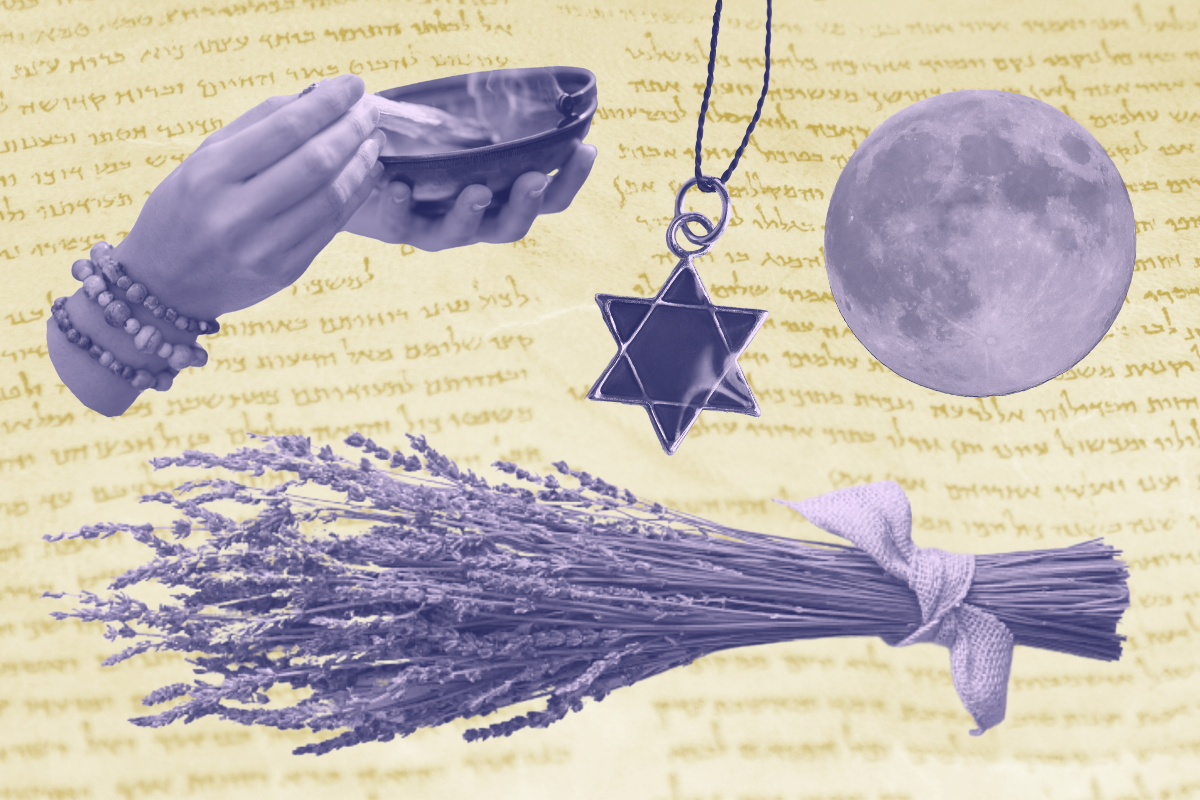As a Jewish spiritual leader, I find it heartbreaking when folks with Jewish ancestry tell me they don’t feel “Jewish enough.” What does that mean? I ask. Almost always they say something about not keeping kosher or Shabbat, or not going to synagogue.
Do you know who decided kosher, Shabbat and synagogue were the salient characteristics of Jewishness? A bunch of men. Mostly after the Holocaust. Kosher, Shabbat and synagogue can be beautiful and meaningful practices, but there have always been many different ways to be Jewish and to nurture a relationship with the ancestors and with the Divine within us, between us and beyond us. Including ways less vaunted by our male ancestors. For example: witchcraft.
Witchcraft, the practice of marginalized people — usually women — using mysterious or taboo natural or spiritual powers to try to clarify or alter material reality, is very Jewish. If you feel the need to evaluate how Jewish you are and you’d like to call upon a more female-centric definition of the term, you might ask: How witchy am I?
Because of colonialism and antisemitic atrocities and because our own male ancestors devalued our female ancestors’ devotion, we’ve lost access to many of the particulars of Jewish witchcraft. These days, excavating the story of ancient Jewish witches can feel like a treasure hunt in a dung heap: we have to reverse engineer from the insults of some of our ancient fathers a picture of our ancient mothers. But there’s also something very beautiful about this practice. It’s what the mystics call “White Fire Torah.” Black Fire Torah is the inky text of the sacred scroll. White Fire Torah is the emerging secret message formed in the negative spaces between the letters, narratives written in silence. Jewish mystics say that this overlooked background is even holier and more profound than the black fire Torah that’s been celebrated at the heart of our tradition.
And Jewish mystics like Reb Zalman Schachter-Shalomi zt”l say that this overlooked background is the story of Jewish women. When we bring to light the wisdom of Jewish witchcraft, we’re engaging in the sacred practice of learning White Fire Torah.
Jewish witches appear in every era of our people’s history, but I want to focus on witchcraft in the Talmud, a third- to sixth-century sacred text that records the ways in which a group of scholars reinvented Judaism after the colonization, decimating massacres and expulsions at the turn of the millennium. Almost everything we consider Jewish today emerges from or is profoundly shaped by the Talmud.
In the period of the Talmud, witchcraft seems to have been ubiquitous. The rabbis say: most women are familiar with witchcraft, and Hillel the Elder, one of the most influential and wise of the Talmudic rabbis declares: More women, more witchcraft. (In Hebrew, it rhymes.)
The boundaries between witchcraft and rabbinics are not always clear. Rabbi Eliezer ben Hyrcanus, a 1st and 2nd century rabbi in Judaea, boasts of planting an entire field of cucumbers with one spell and harvesting them with a second. As my teacher HaRav Kohenet Jill Hammer am”osh put it to me: Magic is a political term, used for non-authorized spiritual practitioners usually working with individuals under the radar. Other than that, witches might not be doing things that are different from authorized spiritual practitioners.
There’s a layer of intersectionality present in witchcraft that still echoes out today: Throughout history, in places where Jews have been an oppressed minority and “non-authorized spiritual practitioners,” they have been accused of witchcraft, sometimes to terrible ends. There’s a poignant story in the Talmud to that effect: A non-Jew interrogates the canonical sage Rabbi Yochanan ben Zakkai, saying that certain Jewish purity practices sound like witchcraft. Rabbi Yochanan ben Zakkai asks about the non-Jew’s own practices, which turn out to bear a remarkable resemblance to the Jewish practices. Rabbi Yochanan ben Zakkai points that out, retorting, “May your ears hear what comes out of your mouth!”
When the rabbis of the Talmud, desperate to maintain a patriarchal monopoly on God, deride the witchy spiritual practices of Jewish women that sound much like their own spiritual practices, it’s tempting to echo: May your ears hear what comes out of your mouths!
Tucked away in the lesser-known Jerusalem Talmud, we find a particularly brutal (although probably fantastical) tale of the prejudice some of our fathers had about the devotion of some of our biological or spiritual mothers:
On a stormy day, Shimon ben Shetach, a 1st Century BCE prince of the Judean council, gathered eighty men, eighty fresh outfits and eighty amphoras and put an amphora with clothes upside down on each man’s head to keep the clothes dry. Shimon brought the men to the entrance of a cave in Ashkelon where a coven of witches lived and instructed them to wait outside the cave until he whistled. Shimon changed his own clothes and swiftly entered the cave and declared himself a witch to the women there. (Witchcraft was dominated by women, but did include male practitioners).
How did you get here dry? the witches asked.
He said: I walked between the raindrops.
The witches welcomed him warmly, casting spells to produce bread, meat, dishes, and wine.
Then they asked Shimon: What magic can you do?
Shimon said: When I whistle, I can conjure up eighty men in dry clothing to entertain you.
That is what we desire, the witches said.
So Shimon whistled and his men, waiting in the pouring rain, pulled their dry clothing out of the amphoras, threw them on and ducked into the cave. Once inside, each man seized a witch and lifted her from the ground. Disconnected from the earth, the witches had no power.
Shimon taunted the women: Conjure up bread! Conjure up food! Conjure up wine!
None could do their magic.
Shimon had every one of the women hung that very day.
This story takes place during a time of vicious in-fighting and civil war — it’s not simply a misogynistic legend. It’s also a story about Shimon’s efforts to consolidate the power of his political/religious party in a period of conflict. But we can’t overlook the misogyny.
As we read this story, our hearts breaking for our ancient mothers, we can also dial in to the White Fire Torah of the story. Without meaning to, this story shares lessons of Jewish witchcraft. It tells us that Jewish witches may have sometimes lived in all-female enclaves. Jewish witches were believed to use incantations to conjure up food and drink. Jewish witches were believed to be sexual beings, sometimes interested in male company, and capable of making that decision freely for themselves. The connection of Jewish witches to the earth was believed to be so profound that lifting them from the earth severed their magical ability.
It’s important to note that not all of the rabbis shared Shimon ben Shetach’s attitude towards witchcraft. Four centuries later and six hundred miles away, Abaye, a Babylonian Talmudic rabbi whose respect for female wisdom was so great that he frequently quoted his foster mother as an authority, taught that the Jewish laws of witchcraft were complex and nuanced, just like the laws of Shabbat. He said:
Some practices of witchcraft are so damaging that if a person does them they are liable for the death penalty.
Some practices of witchcraft are permitted by the Torah but forbidden by the rabbis. Some practices of witchcraft are completely permitted by the Torah.
Regardless of shifting male rabbinic attitudes, Jewish practices of witchcraft survived long after the Talmudic period in Sephardic and Ashkenazi domestic lineages, and also sublimated into the male-dominated arena of “practical Kabbalah.” More recently, the lost witchcraft practices of our ancient mothers have been excavated by early Jewish feminists, the modern Kohenet movement, and emerging Jewish spiritual leaders like Dori Midnight. Witchcraft has begun to reappear in Jewish communities — including in the community I lead, Temple of the Stranger.
If you’re looking to strengthen your Jewish identity, I encourage you to explore kosher, Shabbat and synagogue, but you might also call on our lost ancestral witchcraft traditions and cast an incantation bowl, make a protective amulet or simply go outside and plant your bare feet in the dirt, reconnecting yourself to the earth. As your toes dig into the mud, you might imagine the spirits of our ancient mothers flocking around you from the spirit world, wrapping you in their embrace. If you listen closely enough to the silence, you might even begin to decipher the sounds of their White Fire voices whispering in your ear, saying:
The Jewish people have been waiting a very long time for you, child.
You know exactly what you need to know to begin to walk this path.
Thank Goddess you’re finally here.



